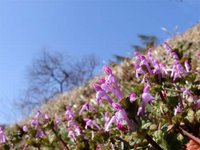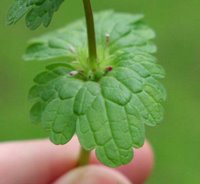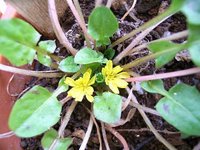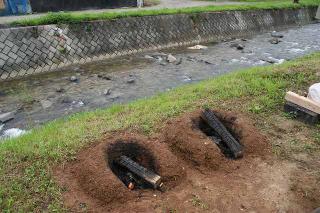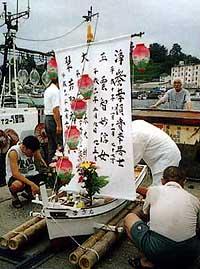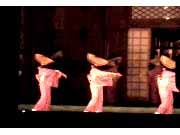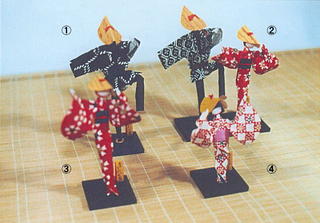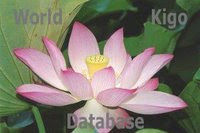[ . BACK to Worldkigo TOP . ]
:::::::::::::::::::::::::::::::::::::::::::::::::::::::::::::::::::::::::::::::::::::::::::::::::::::
Bon Festival, O-Bon, Obon
***** Location: Japan
***** Season: Early Autumn
***** Category: Observance
*****************************
Explanation
. O-Bon 2011 - After the Earthquake .
O-bon Festival in Japan お盆
by Shizuko Mishima, About Japan 2005
The 13th through 16th of August is called o-bon in Japan. O-bon is a Buddhist event and one of the most important traditions for Japanese people. It is the period of praying for the repose of the souls of one's ancestors. People believe that their ancestors' spirits come back to their homes to be reunited with their family during o-bon.
People clean their houses and offer a variety of food such as vegetables and fruits to the spirits of ancestors in front of a butsudan (Buddhist families altar). The butsudan is decorated with flower and CHOOCHIN, lanterns . On the 13th, chouchins are lit inside houses, and people go to their family's o-haka (graves) to call their ancestors' spirits back home.
In some regions, fires called mukaebi are lit at the entrances to homes to guide the ancestor's spirits.
On the 16th, people bring the ancestor's spirits back to o-haka, hanging chouchins painted with the family crest to guide the ancestors' spirits. In some regions, fires called okuribi are lit at entrances of homes to send the ancestors' spirits. The air in houses and cemeteries are full of smoke and the smell of incense called senko at this time.
Bon Dance
During o-bon, bon odori (folk dances) are held all over Japan. The kind of dance varies from area to area. People wearing yukata (summer kimono) go to the neighborhood shrine, temple, or park and dance around a yagura (stage) set up there. Anyone can participate in the dance. Join the circle and imitate what others are doing. Awa odori of Tokushima and bon odori at Yasukuni Shrine, Tokyo are very famous.
Also, Toro Nagashi (floating paper lanterns) are held in some areas. On the evening of the 15th, people send off ancestor's spirits with a paper lantern, lit by a candle inside and floated down a river to the ocean. Firework Displays (hanabi-taikai) are often held during o-bon. It is a typical Japanese summer scene to see hanabi.
Since o-bon is an important family gathering time, many people return to their hometowns during o-bon.
Most businesses are closed during this time. Although it is crowded everywhere, it is common for many people take trips during o-bon, too. The beginning and end of o-bon are marked with terrible traffic jams. Airports, train stations, and highways are jammed with travelers. I recommend you do not travel around o-bon!
© About Japan
http://gojapan.about.com/cs/japanesefestivals/a/obonfestival.htm
http://gojapan.about.com/cs/japanesefestivals/a/obonfestival_2.htm
|
. sorei 祖霊 ancestral spirits - details .
More about the light offeringst
Light offerings afloat (tooroo nagashi 燈籠流)
more kigo in the database
Koya San in Wakayama 高野山
:::::::::::::::::::::::::::::::::::::::::::::::::::::::::::::::::::::::::::::::::::::::::::::::::::::
Next to the New Year celebrations, O-Bon (Obon) is one of the most important festivals to unite the family. It comes with many local customs and all of these can be used as kigo in haiku.
I will try and introduce some of them here.
.................................................................................
 source : teramusume.blogspot.jp
kamabuta tsuitachi 釜蓋朔日 (かまぶたついたち)
source : teramusume.blogspot.jp
kamabuta tsuitachi 釜蓋朔日 (かまぶたついたち)
opening the chauldron on the first day
tonboo tsuitachi 蜻蛉朔日(とんぼついたち)
first day of the dragonflies
On the first day of the seventh lunar month (now August 1) the chauldron of hell was opened to let the souls out for their visit to the family graves.
From this day on, the Urabon ceremonies were started.
. all about the 釜蓋 Kamabuta pot lid .
Kamafuta Jinja 釜蓋神社 "Kamafuta Shrine" , Kagoshima
.................................................................................
. Bon no ichi 盆の市(ぼんのいち) Bon Market .
A market that sells all the things necessary for the Bon celebrations.
It used to start on the evening of the 12th.
.................................................................................
visiting the ancestor's graves in preparation for O-Bon
... hakamairi, haka mairi 墓参 (墓参り)
visiting graves, bonsan 盆参
cleaning the grave, especially the weeds
....tenboo 展墓
scrubbing off the moss from the graves, sootai 掃苔
washing the grave stones, haka arau 墓洗う
..... These preparations are done a few days ahead of the Bon festival.
 welcoming fire at the gates, mukaebi 迎え火
welcoming fire at the gates, mukaebi 迎え火
Festival for the souls, tama matsuri 魂祭
Bon Festival, O-Bon, Obon お盆、盆
Lantern Festival, Festival of the Dead, Ancestor's Festival
..... Urabon, Ura-Bon 盂蘭盆, urabon-e 盂蘭盆会
..... boni ぼに
..... Bon-e 盆会 Bon celebration
August 13 - 15
Bon Lantern, bonjoochin, bon choochin 盆提灯
Bon Dance, bon odori 盆踊り
including - Bon Dance in Awa, Awa odori 阿波踊り

Tower for the Bon Dance, bon yagura 盆櫓
okuribon 送り盆 (おくりぼん) last day of O-Bon
..... shimai bon, shimaibon しまい盆(しまいぼん)、
urabon 裏盆(うらぼん)"Back of O-Bon"
bongu nagashi 盆供流し(ぼんぐながし)floating the Bon offerings
sending-off fire, okuribi 送り火
sending off the souls, tama okuri 霊送り/ 魂送
Eggplant Horse and other vegetable BON decorations
nasu uma 茄子馬
 shelf for Bon offerings, bondana 盆棚
shelf for Bon offerings, bondana 盆棚
shelf for the souls, shooryoodana 精霊棚
shelf for the ancestors, sensodana 先祖棚
tamadana, tama-dana 玉棚 "decoration shelf"
empty shelf, karadana 空棚
shelf for the sutras, tanagyoo 棚経
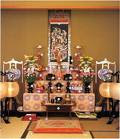 first bon ceremony, hatsubon, hatsu bon 初盆, shinbon 新盆, niibon
first bon ceremony, hatsubon, hatsu bon 初盆, shinbon 新盆, niibon
..... for a person who died since the last O-Bon. There are many special rituals for the family to perform, which are different in many areas of Japan.
..... mizu no ko, mizuko 水の子、水子(みずのこ)unborn child
..... mizu no mi 水の実(みずのみ)
aratana 荒棚(あらたな) provisional shelf
arabon あら盆(あらぼん)provisional Bon
niijooro 新精霊 "new soul"
shinbon mimai 新盆見舞(しんぼんみまい)visiting a home with a new Bon
shooryoo matsuri, shooryoomatsuri 精霊祭 Festival of the Souls
. mizuko kuyoo 水子供養 service for unborn children .
preparations for o-bon, bonjitaku 盆仕度 (ぼんじたく)
..... bonyooi 盆用意 (ぼんようい)
before o-bon, bon mae 盆前
holidays during o-bon, bon yasumi 盆休み (ぼんやすみ)
..... usually three days, when people travel home to visit the graves of the ancestors
after o-bon, bon sugi 盆過ぎ (ぼんすぎ)
. hasu no meshi 蓮の飯 (はすのめし) rice with lotus .
. nanukabon 七日盆(なぬかぼん)
O-Bon preparations beginning on the 7th of August .
including cleaning of ponds, wells and graves
bonsekki 盆節季 (ぼんせっき) Bon season
bon no kakegoi 盆の掛乞(ぼんのかけごい)payment at O-Bon
..... bonbarai 盆払(ぼんばらい)
..... bon kanjoo 盆勘定(ぼんかんじょう)
During the Edo period, many people bought on loan and payed their debts twice a year, at O-bon and before the New Year holidays.
. kakegoi 掛乞 last payment of the year .
.................................................................................
In the
Buddhist Saijiki of our database you can find many more kigo related to O-Bon.
WKD : Saijiki of Buddhist, Shinto and other Ceremonies
Graves (haka)
:::::::::::::::::::::::::::::::::::::::::::::::::::::::::::::::::::::::::::::::::::::::::::::::::::::
.. .. .. .. .. Links about O-Bon
The O-Bon ABC. The most detailed explanations.
http://www.bonodori.net/E/sekai/bonabc1.HTML
Safekeep copy without photos is here:
O-Bon / ABC
Japanese haiku about O-Bon
盂蘭盆チャット句会2003
Suien Obon Chat Taikai
*****************************
Worldwide use
Hawaii
The Obon in Hawai'i
This Buddhist observance honoring the ancestors came to Hawai`i in the late 19th century with a large wave of Japanese immigrants. Obon is observed in Hawai`i during the summer months, when family members place flowers and food on the graves of ancestors and friends and recite the nembutsu, an expression of appreciation, before the family altar.
 © Photo: Melvin M. Takahashi
© Photo: Melvin M. Takahashi
The centerpiece of the ceremony is the
bon dance.
It is believed that the first bon dances were performed in the fields where the immigrants labored, and in between houses on the plantation. Later dances were held in temple courtyards. As work schedules began to conform to the Western five-day week, bon dances began to be scheduled for weekends. The bon dance is a way of expressing gratitude to ancestors and loved ones no longer here. It is a way of reflecting upon the preciousness and fragility of this life. Even though the sense of loss of family and loved ones is strong, a festive mood prevails at the dance.
Although the dance nearly died out with the onslaught of anti-Japanese fervor that swept Hawai`i during the '40s, a post WW II event spurred its revival in 1951 when four Japanese-American veterans' groups sponsored a bon dance to honor the war dead from Hawaii. That revival was also powered by tourism and the convergence of several island traditions: interfaith services, interracial marriages, racial harmony, and bon dance clubs.
Today the bon dancers are not only Japanese Buddhists, but Filipino, Chinese, Korean, Portuguese and native Hawaiian, Protestant and Catholic. Bon dance clubs in recent years have enlivened the bon dance tradition. Each bon dance club specializes in the music and dance of one of the prefectures of Hawaii's immigrants. Some clubs provide musicians and group of dancers to lead the dancing, while others provide only the music.
Over the years, the ceremony and the practice of Buddhism itself underwent significant change to adapt to the islands' multicultural society. The 23-page essay submitted as part of the project explores the history of that transformation and the present place of the Obon in Hawaiian culture.
© by Local Legacies Hawaii
http://www.loc.gov/bicentennial/propage/HI/hi_s_akaka4.html
*****************************
Things found on the way
senzo matsuri 先祖まつり festival of the ancestors
On the island Mikurajima 御蔵島 there is no temple any more, only a shrine 祖霊社 to celebrate during O-Bon, O-Higan and other festivals.
So now they celebrate this festival twice a year during the equinox. During the rituals, girls of the age of 15 are allowed to wear a long-sleeve kimono for the first time, to present them to the ancestors as "little women".
After a ceremony at the shrine, people eat mochi ricecakes and sweets in white and red auspicious colors.
source : satoyumi
*****************************
HAIKU
okuribi ya
jiisan baasan no
kami shiroki
sending-off fires -
Grandfather and Grandmother
their hair so white
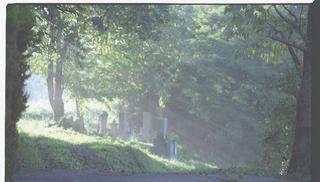
Nobody had come this year from the neighbour's family for the celebrations. So the two of them where all alone in the apple orchard in the Western part of the estate, symbolizing the Paradise of the West, where the graves are located, to send off the ancestor's souls.
I have written a bit more on the rural family graves here:
http://happyhaiku.blogspot.com/2004/10/lonely-graves-in-mist.html
Gabi Greve, 2005
:::::::::::::::::::::::::::::::::::::::::::::::::::::::::::::::::::::::::::::::::::::::::::::::::::::
家はみな杖に白髪の墓参り
ie wa mina tsue ni shiragami no hakamairi
all family members
with canes and white hair
visiting graves
Matsuo Basho 松尾芭蕉, 1656 明暦2
at the local shrine of his village at Iga Ueno
The whole family--
All with white hair and canes
visiting graves
Tr. Jane Reichhold
- - - - -
数ならぬ身とな思ひそ玉祭り
. kazu naranu mi to na omoi so tama matsuri .
for his wife, Jutei-Ni 寿貞尼 Juteini, the Nun Jutei
MORE - hokku about the tsue - walking stick by
. Matsuo Basho 松尾芭蕉 - Archives of the WKD .
:::::::::::::::::::::::::::::::::::::::::::::::::::::::::::::::::::::::::::::::::::::::::::::::::::::
12 Bon Lantern Haiku by Kobayashi Issa
同じ年の顔の皺見ゆる灯篭哉
onaji toshi no kao no shiwa miyuru tôro kana
a wrinkled face
he's my age...
lanterns for the dead
.. .. .. .. ..
よそ事と思へ思へど灯篭哉
yoso-goto to omoe omoedo tôro kana
someone else's affair
you think...
lanterns for the dead
... //cat.xula.edu/issa/
..............................
13 Haiku by Issa about the Bon Festival Dance
山かげの一軒家さへおどり哉
yama kage no ikken-ya sae odori kana
an isolated house
in mountain shade
but a festival dance!
.. .. .. .. ..
踊から直に朝草かりにけり
odori kara sugu ni asa kusa kari ni keri
after the dance
right away, cutting
the morning grass
.. http://haikuguy.com/issa/
Cutting the grass and weeds in the morning, when it is still cool, is a way of doing things even nowadays. My husband also is on weed cutting duty most mornings...
Gabi Greve, Japan 2005
..............................
Issa on the seeing-off fire
送り火や今に我等もあの通り
okuribi ya ima ni warera mo ano tôri
fires for the dead
soon enough they'll burn
for us
http://haikuguy.com/issa/
..............................
Issa on the Buddhist Shelf for the Souls
魂棚や上座して鳴くきりぎりす
tama-dana ya jooza shite naku kirigirisu
Buddhist shelf--
in the seat of honor
a katydid chirrs
Sakuo Nakamura notes that the katydid singing in the honored place of the altar takes on the role of Issa's ancestor. The Buddhist shelf (tama-dana) is an altar for the spirits of the dead used during the Bon Festival. The Bon Festival of the Dead takes place in Eighth Month in the old lunar calendar. At this time, people light lanterns to guide their ancestors' spirits back home.
A katydid (kirigirisu) is a green or light brown insect, a cousin of crickets and grasshoppers. The males possess special organs on the wings with which they produce shrill calls. Although katydid is the closest English equivalent, many translators (such as R. H. Blyth) use the more familiar "grasshopper" and "cricket." See Haiku (Tokyo: Hokuseido, 1949-1952; rpt. 1981-1982/reset paperback edition) 4.1068-69.
..............................
玉棚に必風の吹といふ
tama-dana ni kanarazu kaze no fuku to iu
on the ancestors' altar
without fail
a lucky wind blows
Tr. David Lanoue
on the Bon offering shelf
there is usually a wind
blowing
Tr. Gabi Greve
It can be interpreted as a play with words,
kaze no fuku, FUKU meaning good luck or just blowing of the wind.
It could simply mean that during the O-Bon season there is often a wind blowing (often even a typhoon coming).
:::::::::::::::::::::::::::::::::::::::::::::::::::::::::::::::::::::::::::::::::::::::::::::::::::::
迎え火や山から続く村の道
mukaebi ya yama kara tsuzuku mura no michi
wellcoming fire -
from the mountain down
a road to the village
(Tr. Gabi Greve)
© 能生町・矢沢龍蔵 Yazawa Ryuuzoo
http://www.lib.itoigawa.niigata.jp/np/2003-9.htm
xxxxxxxxxxxxxxxxxxxxxxxxxxxxx
水色を軒端に吊るす盆提灯
mizu-iro o nokiba ni tsurusu bon choochin
water-colored
hanging down from the eves -
bon lantern
(Tr. Gabi Greve)
© Keiji けいじ
http://www.suien.ne.jp/0001/chat/bon03a.htm
xxxxxxxxxxxxxxxxxxxxxxxxxxxxx
少年の野太き声や盆仕度
shoonenn no nobutoki koe ya bon jitaku
the loud wild voice
of a young boy -
preparing for o-bon
(Tr. Gabi Greve)
茜由の俳句 Senyuu no haiku
http://homepage2.nifty.com/senyuu/haiku-2003.htm
*****************************
Related words
*****
Saijiki for Buddhist Ceremonies and Events
*****
Awaodori Dance Japan, Bon-Odori, Bon-Dance
Bon Festival (o-bon お盆) and Autumn festivals Japan
(contains all the O-Bon kigo)
.....
Bon Boats for Souls (shooryoobune) Japan
.....
Bon Flowers (bonbana) Japan
.....
Bon Stove (bongama) Japan
.....
Bon of Wind (kaze no bon) Japan
.....
Jizobon, Jizoo Bon Japan
.....
Tug of war (Bon Tsunahiki 盆綱引) Japan
Bon Lanterns (bonchoochin) and other lanterns
Light offerings afloat (tooroo nagashi)
ikegaebon, ikekae bon 池替え盆(いけかえぼん)cleaning the pond "for O-Bon"
:::::::::::::::::::::::::::::::::::::::::::::::::::::::::::::::::::::::::::::::::::::::::::::::::::::
. Hungry Ghost Festival .
Celebrated on the 15th day of the 7th Lunar month in Asia.
[ . BACK to WORLDKIGO . TOP . ]
[ . BACK to DARUMA MUSEUM TOP . ]
:::::::::::::::::::::::::::::::::::::::::::::::::::::::::::::::::::::::::::::::::::::::::::::::::::::










